Inhibitory Effect of Polypeptides Produced by Brevibacillus brevis on Ochratoxigenic Fungi in the Process of Pile-Fermentation of Post-Fermented Tea
Abstract
:1. Introduction
2. Materials and Methods
2.1. Strains, Materials and Reagents
2.2. Instruments and Equipment
2.3. Preparation and FT-IR Spectral Evaluation of Polypeptides (Molecular Weight from 3 kDa to 5 kDa) of B. brevis
2.4. Inhibition Effects of Polypeptides on the Growth of A. carbonarius H9
2.5. Inhibition of A. carbonarius H9 on Sterilized Tea by Polypeptides
2.6. Determination of Conidial Survival Rate of A. carbonarius H9
2.7. Effects of Polypeptides on the Integrity of Mycelium Membrane of A. carbonarius H9
2.8. Determination of Membrane Integrity of A. carbonarius H9 Spore
2.9. Determination of Extracellular Conductivity of A. carbonarius H9
2.10. The Expression Analysis of Genes Related OTA Production in A. carbonarius H9 by RT-PCR
2.11. Statistical Analysis
3. Results and Discussion
3.1. Anti-Fungal Peptides Produced by Brevibacillus brevis DTM05
3.2. Inhibition Effects of the Polypeptides on the Growth of A. carbonarius H9
3.3. Inhibitory Effects of Polypeptides on the Growth of A. carbonarius H9 on Tea Matrix
3.4. Effect of Polypeptides on Spore Cell Membrane Integrity of A. carbonarius H9
3.5. Effect of Anti-Fungal Peptides on Mycelia Cell Membrane Integrity of A. carbonarius H9
3.6. Effect of Anti-Fungal Peptides on Extracellular Conductivity of A. carbonarius H9
3.7. Effect of Anti-Fungal Peptides on the Expression of Genes Related to OTA Production in A. carbonarius H9
4. Conclusions
Author Contributions
Funding
Data Availability Statement
Conflicts of Interest
References
- Zhao, Z.-J.; Tong, H.-R.; Zhou, L.; Wang, E.-X.; Liu, Q.-J. Fungal colonization of Pu-erh tea in Yunnan. J. Food Safety 2010, 30, 769–784. [Google Scholar] [CrossRef]
- Zhang, Y.-J.; Skaar, I.; Sulyok, M.; Liu, X.-Z.; Rao, M.-Y.; Taylor, J.-W. The microbiome and metabolites in fermented Pu-erh tea as revealed by high-throughput sequencing and quantitative multiplex metabolite analysis. PLoS ONE 2016, 11, e0157847. [Google Scholar] [CrossRef] [PubMed] [Green Version]
- Yan, K.; Abbas, M.; Meng, L.; Cai, H.; Peng, Z.; Li, Q.; El-Sappah, A.; Yan, L.; Zhao, X. Analysis of the fungal diversity and community structure in sichuan dark tea during pile-fermentation. Front. Microbiol. 2021, 12, 2041. [Google Scholar] [CrossRef] [PubMed]
- Zhao, Z.-J.; Hu, X.-C.; Liu, Q.-J. Recent advances on the fungi of Pu-erh ripe tea. Int. Food Res. J. 2015, 22, 1240–1246. [Google Scholar]
- Zheng, P.-C.; Tan, R.-R.; Liu, P.-P.; Wang, S.-P.; Teng, J.; Wang, X.-P.; Gong, Z.-M. Study on the fungi species and quality changes of green brick tea during pile-fermentation process. Food Sci. Technol. 2017, 42, 22–26. [Google Scholar]
- Mao, Y.; Wei, B.Y.; Teng, J.W.; Huang, L.; Xia, N. Analyses of fungal community by Illumina MiSeq platforms and characterization of Eurotium species on Liupao tea, a distinctive post-fermented tea from China. Food Res. Int. 2017, 99, 641–649. [Google Scholar] [CrossRef] [PubMed]
- Sedova, I.; Kiseleva, M.; Tutelyan, V. Mycotoxins in tea: Occurrence, methods of determination and risk evaluation. Toxins 2018, 10, 444. [Google Scholar] [CrossRef] [PubMed] [Green Version]
- Battilani, P.; Magan, N.; Logrieco, A. European research on ochratoxin A in grapes and wine. Int. J. Food Microbiol. 2006, 111, S2–S4. [Google Scholar] [CrossRef] [PubMed]
- Perrone, G.; Mule, G.; Susca, A.; Battilani, P.; Pietri, A.; Logrieco, A. Ochratoxin a production and AFLP analysis of Aspergillus carbonarius, Aspergillus tubingensis, and Aspergillus niger strains isolated from grapes in Italy. Appl. Environ. Microb. 2006, 72, 680–685. [Google Scholar] [CrossRef] [Green Version]
- Zhao, Z.-J.; Lou, Y.-G.; Shui, Y.-C.; Zhang, J.; Hu, X.-C.; Zhang, L.-L.; Li, M.-Q.; Wu, H.-W.; Li, X.-H. Ochratoxigenic fungi in post-fermented tea and inhibitory activities of Bacillus spp. from post-fermented tea on ochratoxigenic fungi. Food Control 2021, 126, 108050. [Google Scholar] [CrossRef]
- Hou, C.-W.; Jeng, K.-C.; Chen, Y.-S. Enhancement of fermentation process in Pu-erh tea by tea-leaf extract. J. Food Sci. 2010, 75, H44–H48. [Google Scholar] [CrossRef] [PubMed]
- Arroyo, M.; Aldred, D.; Magan, N. Environmental factors and weak organic acid interactions have differential effects on contro of growth and ochrataxin A production by Penicillium verrucosum isolates in bread. Int. J. Food Microbiol. 2005, 98, 223–231. [Google Scholar] [CrossRef] [PubMed]
- Esteban, A.; Abarca, M.-L.; Bragulat, M.-R.; Cabanes, F.-J. Study of the effect of water activity and temperature on ocharatxin A production by Aspergillus cabonarius. Food Microbiol. 2006, 23, 634–640. [Google Scholar] [CrossRef]
- Deng, X.-J.; Tu, Q.; Wu, X.-X.; Huang, G.-Y.; Shi, H.-Y.; Li, Y.-L.; Zhou, H.-J. Research progress on the safety risk of ochratoxin A in Tea. Sci. Technol. Food Ind. 2021, 42, 405–412. [Google Scholar]
- Cai, D.; Li, X.-D.; Deng, L.-L.; Zeng, K.-F. Antibacterial effect and mechanism of antimicrobial peptide PAF26 on Monilinia fructicola in postharvest plums. Food Sci. 2020, 41, 221–227. [Google Scholar]
- Jiang, C.; Shi, J.; Liu, Y.; Zhu, C. Inhibition of Aspergillus carbonarius and fungal contamination in table grapes using Bacillus subtilis. Food Control 2014, 35, 41–48. [Google Scholar] [CrossRef]
- Yánez-Mendizábal, V.; Zeriouh, H.; Viñas, I.; Torres, R.; Usall, J.; Vicente, A.-D.; Pérez-García, A.; Teixidó, N. Biological control of peach brown rot (Monilinia spp.) by Bacillus subtilis CPA-8 is based on production of Fengycin-like lipopeptides. Eur. J. Plant Pathol. 2012, 132, 609–619. [Google Scholar] [CrossRef]
- Guo, J.; Yun, J.-M.; Deng, Z.-R.; Ai, D.-Y.; Zhang, W.-W.; Zhao, F.-Y. Antimicrobial mechanism of Bacillus pumilus HN-10 antifungal peptide P-1 against Trichothecium roseum. J. Food Sci. 2019, 19, 17–22. [Google Scholar]
- Peng, X.-C.; Yu, M. Isolation and identification of culturable microorganisms in a 10-Year-Old fermented Pu-erh tea. Food Sci. 2011, 32, 196–199. [Google Scholar]
- Sailaja, P.-R.; Podile, A.-R.; Reddanna, P. Biocontrol strain of Bacillus subtilis AF1 rapidly induces lipoxygenase in groundnut (Arachis hypogaea L.) compared to crown rot pathogen Aspergillus niger. Eur. J. Plant Pathol. 1998, 104, 125–132. [Google Scholar] [CrossRef]
- Hassan, Z.-U.; Thani, R.-A.; Alnaimi, H.; Migheli, Q.; Jaoua, S. Investigation and application of Bacillus licheniformis volatile compounds for the biological control of toxigenic Aspergillus and Penicillium spp. ACS Omega 2019, 4, 17186–17193. [Google Scholar] [CrossRef] [PubMed]
- Ghadbane, M.; Harzallah, D.; Laribi, A.-I.; Jaouadi, B.; Belhadj, H. Purification and biochemical characterization of a highly thermostable bacteriocin isolated from Brevibacillus brevis strain GM100. Biosci. Biotechnol. Biochem. 2013, 77, 151–160. [Google Scholar] [CrossRef] [PubMed] [Green Version]
- Luo, B.; Qin, J.Z.; Zhang, C.H. The condition for sporulation of Eurotium cristatum in Fu-brick tea. Food Ind. 2013, 34, 16–18. [Google Scholar]
- Che, J.-M.; Liu, B.; Chen, Z.; Shi, H.; Liu, G.-H.; Ge, C.-B. Identification of ethylparaben as the antimicrobial substance produced by Brevibacillus brevis FJAT-0809-GLX. Microbiol. Res. 2015, 172, 48–56. [Google Scholar]
- Wang, L.; Yang, Q.L.; Zhao, H.-Y. Sub-regional identification of peanuts from Shandong Province of China based on Fourier Transform Infrared (FT-IR) spectroscopy. Food Control 2021, 124, 107879. [Google Scholar] [CrossRef]
- Wang, W.-J.; Deng, L.-L.; Yao, S.-X.; Zeng, K.-F. Control of green and blue mold and sour rot in citrus fruits by the cationic antimicrobial peptide PAF56. Postharvest Biol. Technol. 2018, 136, 132–138. [Google Scholar] [CrossRef]
- Pitt, J.-I.; Hocking, A.-D. Fungi and Food Spoilage, 2nd ed.; Blackie Academic & Professional (Chapman & Hall): London, UK, 1997; pp. 307–309. [Google Scholar]
- Mario, V.; Katherine, M.; Carolina, S.; Mario, A.; Victor, C.; Ricardo, V.; Orialis, V. Solid-phase extraction and HPLC determination of ochratoxin A in cereals products on Chilean market. Food Control 2009, 20, 631–634. [Google Scholar]
- Li, X.-D.; Wang, W.-J.; Liu, S.; Ruan, C.; Zeng, K.-F. Effect of the peptide H-OOWW-NH2 and its derived lipopeptide C12-OOWW-NH2 on controlling of citrus postharvest green mold. Postharvest Biol. Technol. 2019, 158, 110979. [Google Scholar] [CrossRef]
- Paul, S.; Dubey, R.-C.; Maheswari, D.-K.; Sun, C.-K. Trachyspermum ammi (L.) fruit essential oil influencing on membrane permeability and surface characteristics in inhibiting food-borne pathogens. Food Control 2011, 22, 725–731. [Google Scholar] [CrossRef]
- Rachelle, K.; Florence, M.; Ali, A.; Hiba, K.; Anthony, K.; Charbel, A.; Richard, M.; André, K. Ability of soil isolated actinobacterial strains to prevent, bind and biodegrade ochratoxin a. Toxins 2017, 9, 222. [Google Scholar]
- Ma, Q.-P.; Qin, M.-Y.; Song, L.-C.; Sun, H.-W.; Zhang, H.; Wu, H.-H.; Ren, Z.-H.; Liu, H.; Duan, G.; Wang, Y.; et al. Molecular link in flavonoid and amino acid biosynthesis contributes to the flavor of Changqing tea in different seasons. Foods 2022, 11, 2289. [Google Scholar] [CrossRef] [PubMed]
- Long, G.-H.; Ji, Y.; Pan, H.-B.; Sun, Z.-W.; Li, Y.-T.; Qin, G.-X. Characterization of thermal denaturation structure and morphology of soy glycinin by FTIR and SEM. Int. J. Food Prop. 2015, 18, 763–774. [Google Scholar] [CrossRef] [Green Version]
- Liu, L.-L.; Wang, L.-B.; Zonderman, J.; Rouse, J.-C.; Kim, H.-Y. Automated, high-throughput infrared spectroscopy for secondary structure analysis of protein biopharmaceuticals. J. Pharm. Sci. 2020, 109, 3223–3230. [Google Scholar] [CrossRef] [PubMed]
- Hang, B.-L.; Zhang, W.; Li, J.; Xu, J.; Xu, Y.-Z.; Zhang, H.-H.; Hu, J.-H. Bioinformatics analysis of antimicrobial peptide BSN-37. J. Henan Inst. Sci. Technol. 2018, 46, 34–38. [Google Scholar]
- Nunes, K.-M.; Andrade, M.V.O.; Almeida, M.R.; Sena, M.-M. A soft discriminant model based on mid-infrared spectra of bovine meat purges to detect economic motivated adulteration by the addition of non-meat ingredients. Food Anal. Method. 2020, 13, 1699–1709. [Google Scholar] [CrossRef]
- Park, S.-M.; Yu, H.; Chun, H.-S.; Kim, B.-H.; Ahn, S. A second derivative Fourier Transform infrared spectroscopy method to discriminate perilla oil authenticity. J. Oleo Sci. 2019, 68, 389–398. [Google Scholar] [CrossRef] [Green Version]
- Uncu, O.; Ozen, B. A comparative study of mid-infrared, UV-Visible and fluorescence spectroscopy in combination with chemometrics for the detection of adulteration of fresh olive oils with old olive oils. Food Control 2019, 105, 209–218. [Google Scholar] [CrossRef]
- Sinelli, N.; Cosio, M.S.; Gigliotti, C.; Casiraghi, E. Preliminary study on application of mid infrared spectroscopy for the evaluation of the virgin olive oil “freshness”. Anal. Chim. Acta 2007, 598, 128–134. [Google Scholar] [CrossRef]
- Yi, Y.-J.; Liu, Y.; Hou, Z.-P.; Zhao, S.-Y.; Lu, H.; Jia, S.; Li, R.-F. Control and safety evaluation of Bacillus cereus XZ30-2 fermentation supernatant against Aspergillus niger. Modern Food Sci. Technol. 2022, 38, 36–43. [Google Scholar]
- Yang, Z.-B.; Liu, X.-C.; Zhang, M.-D.; Liu, L.-X.; Xu, X.-X.; Xian, J.-R.; Cheng, Z. Effect of temperature and duration of pyrolysis on spent tea leaves biochar: Physiochemical properties and Cd (II) adsorption capacity. Water Sci. Technol. 2020, 81, 2533–2544. [Google Scholar] [CrossRef]
- Hu, X.-D.; Li, Y.; Ren, S.-Y.; Yao, Y.-J. Fluorescent staining of septa and nuclei in Ophiocordyceps sinensis and Cordyceps militaris. Mycosystema 2016, 35, 1100–1105. [Google Scholar]
- Qian, S.; Lu, H.; Meng, P.; Zhang, C.; Lv, F.; Bie, F.; Lu, Z. Effect of inulin on efficient production and regulatory biosynthesis of bacillomycinD in Bacillus subtilis fmbJ. Bioresour. Technol. 2015, 179, 260–267. [Google Scholar] [CrossRef] [PubMed]
- Ling, Y.; Deng, L.-L.; Yao, S.-X.; Zeng, K.-F. Inhibitory effect of L-Cysteine against Monilinia fructicola on postharvest plum fruit. Food Sci. 2019, 40, 256–261. [Google Scholar]
- Gallo, A.; Bruno, K.-S.; Solfrizzo, M.; Perrone, G.; Mule, G.; Visconti, A.; Baker, S.-E. New insight into the ochratoxin A biosynthetic pathway through deletion of a nonribosomal peptide synthetase gene in Aspergillus carbonarius. Appl. Environ. Microb. 2012, 78, 8208–8218. [Google Scholar] [CrossRef] [PubMed]
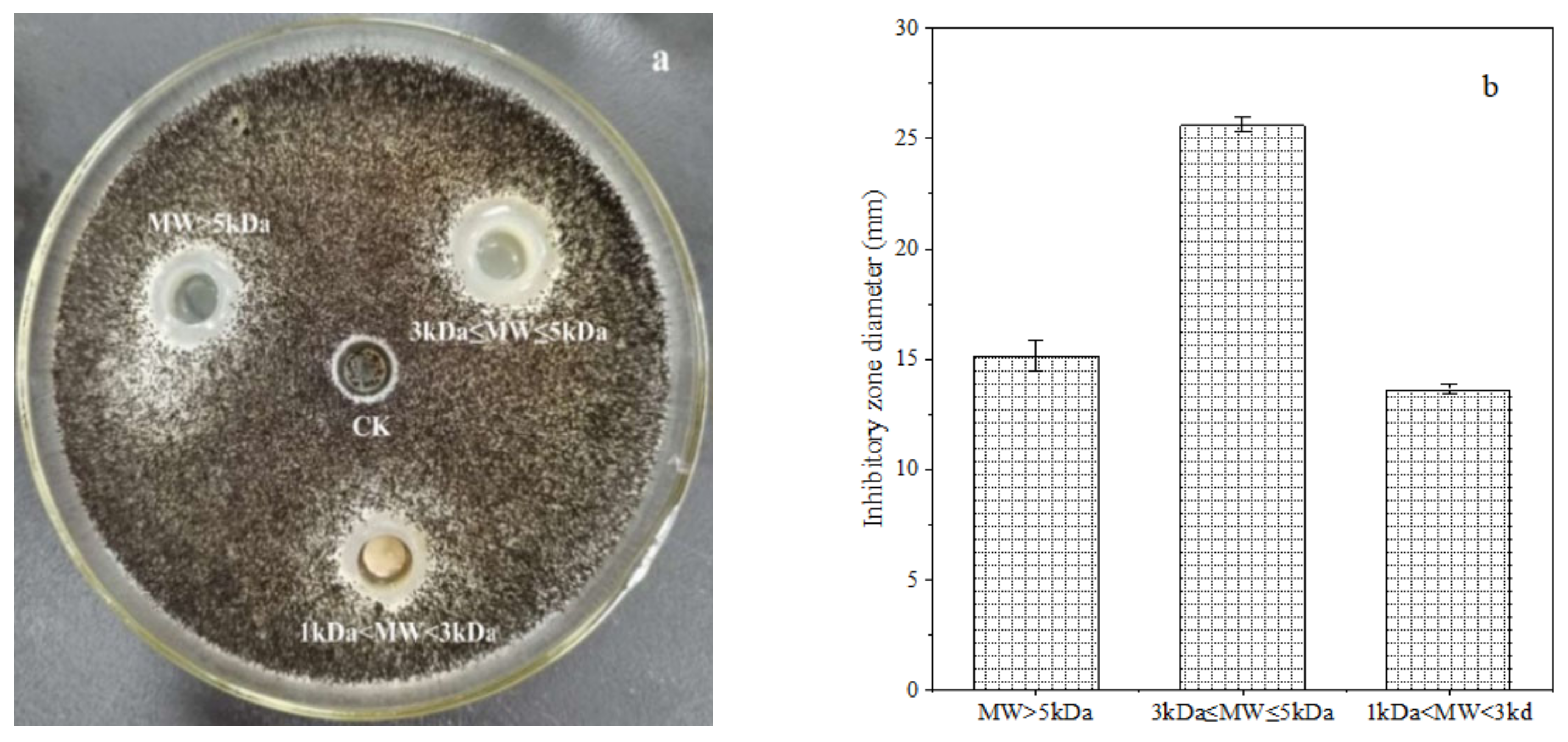
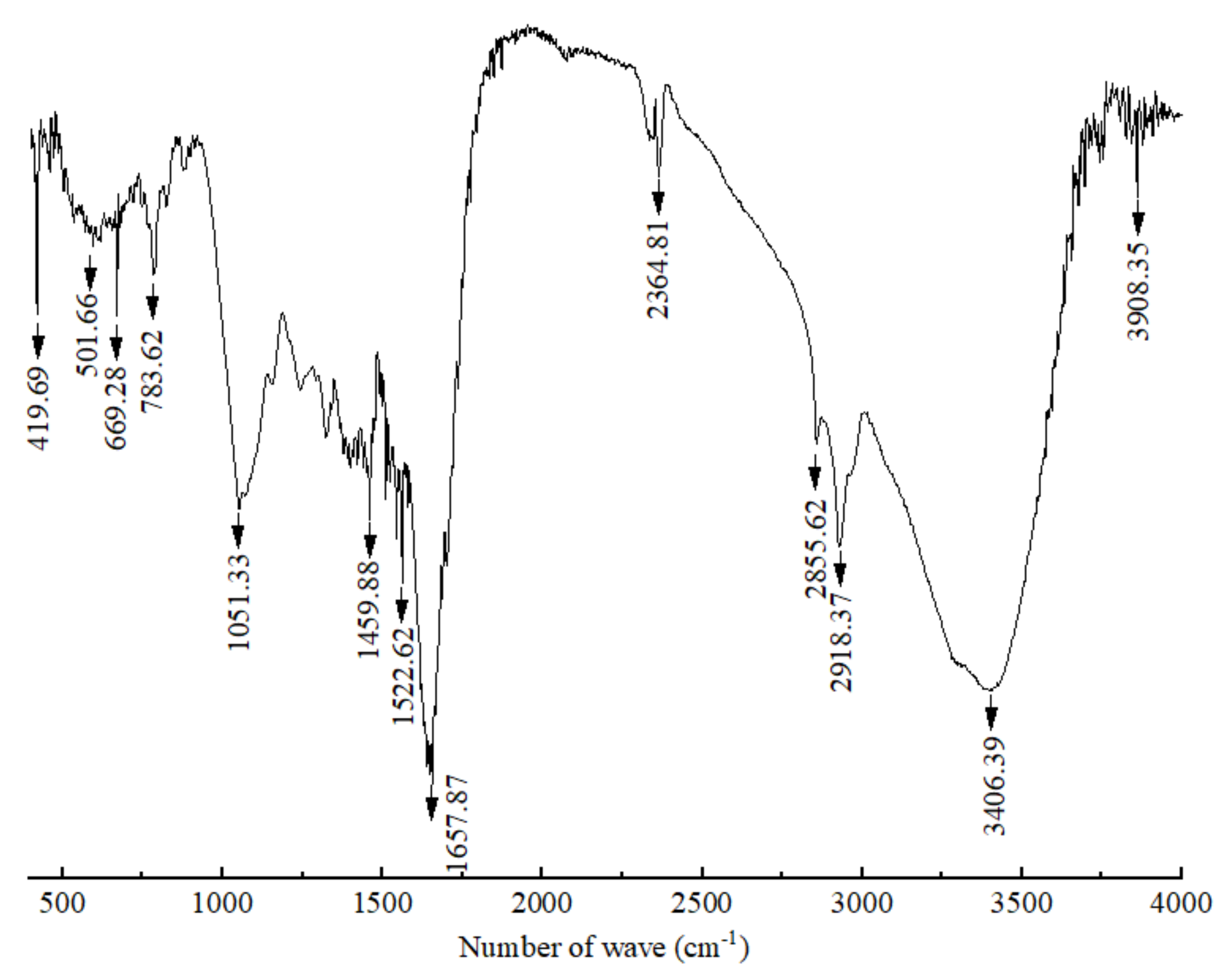
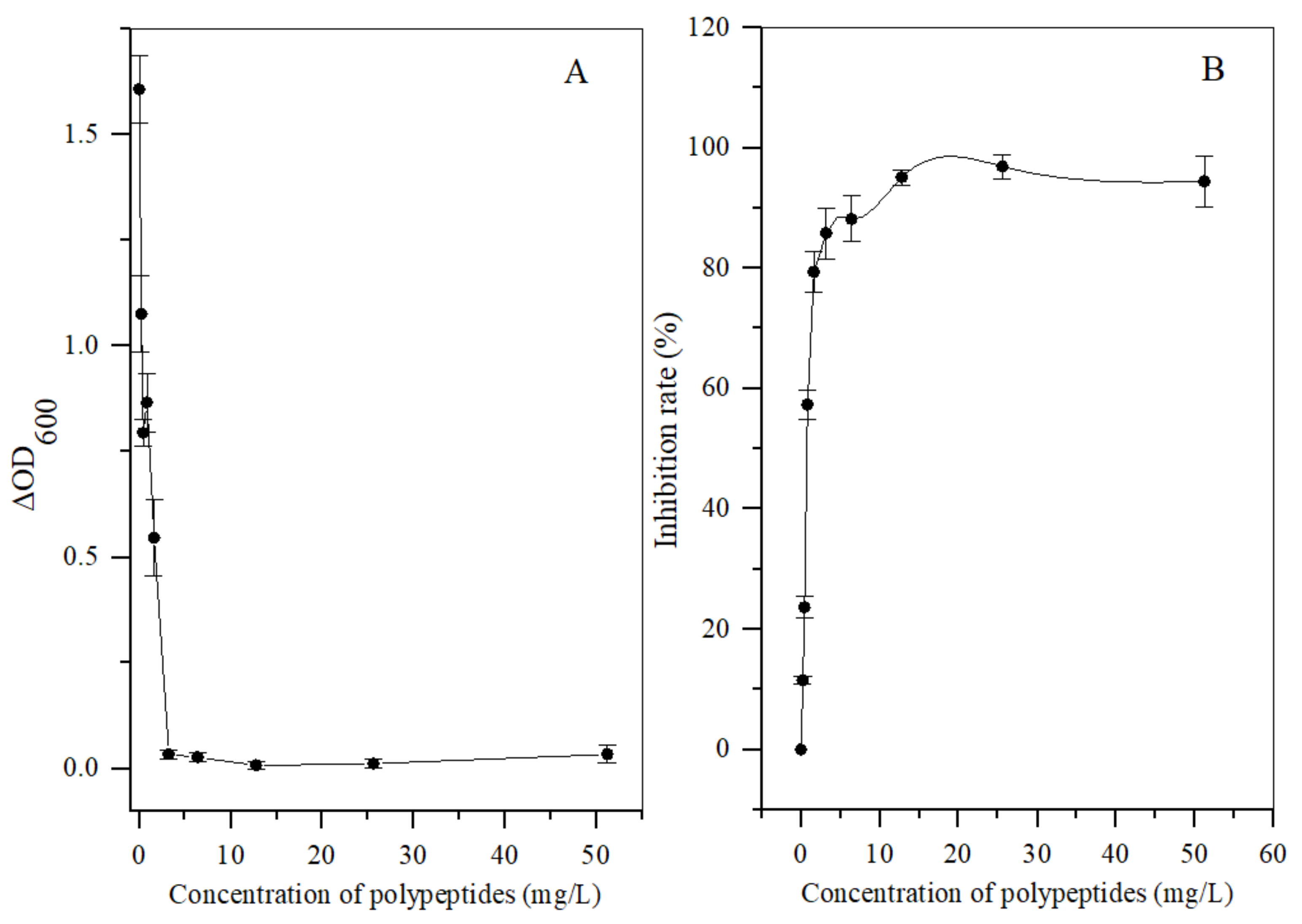

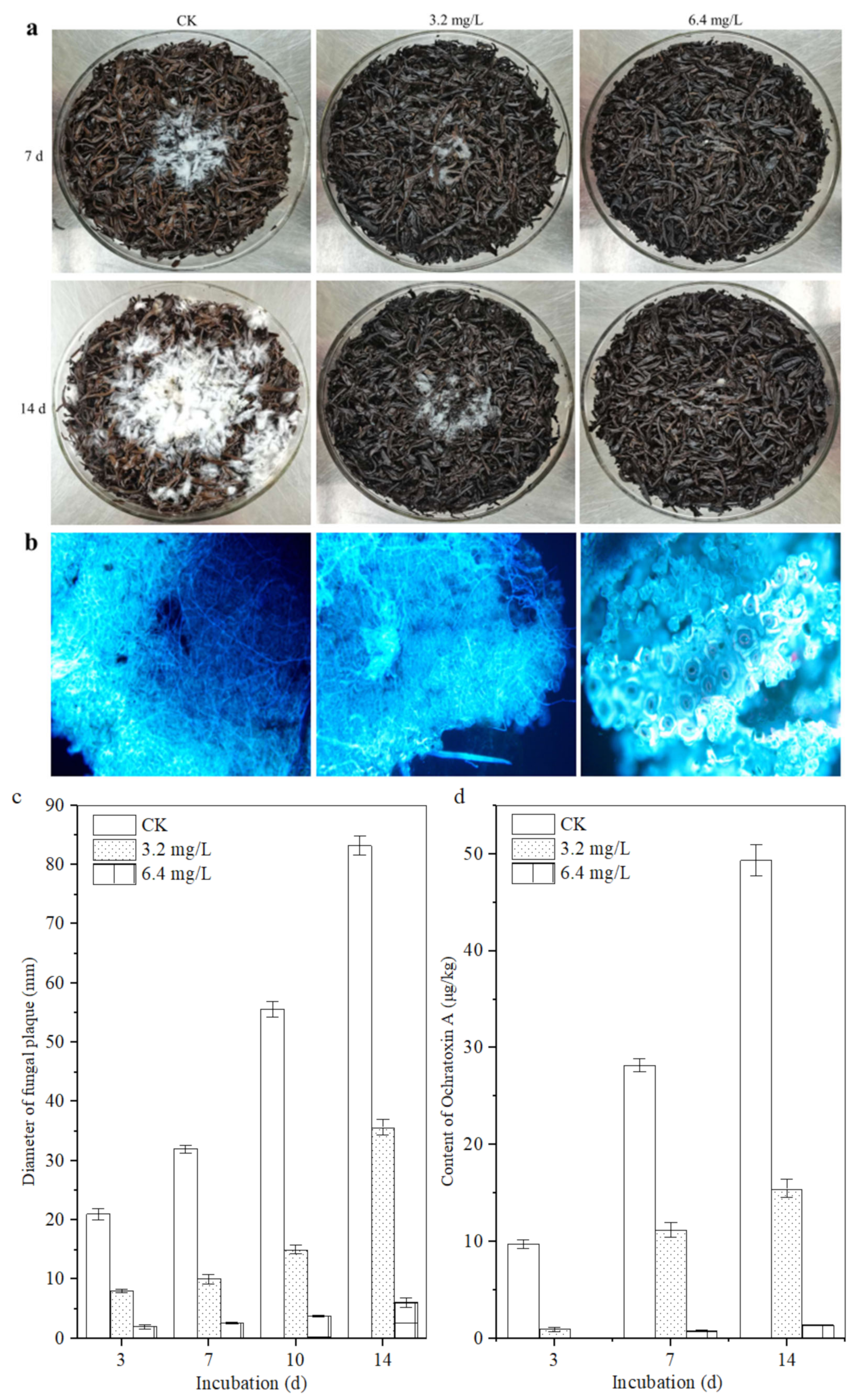
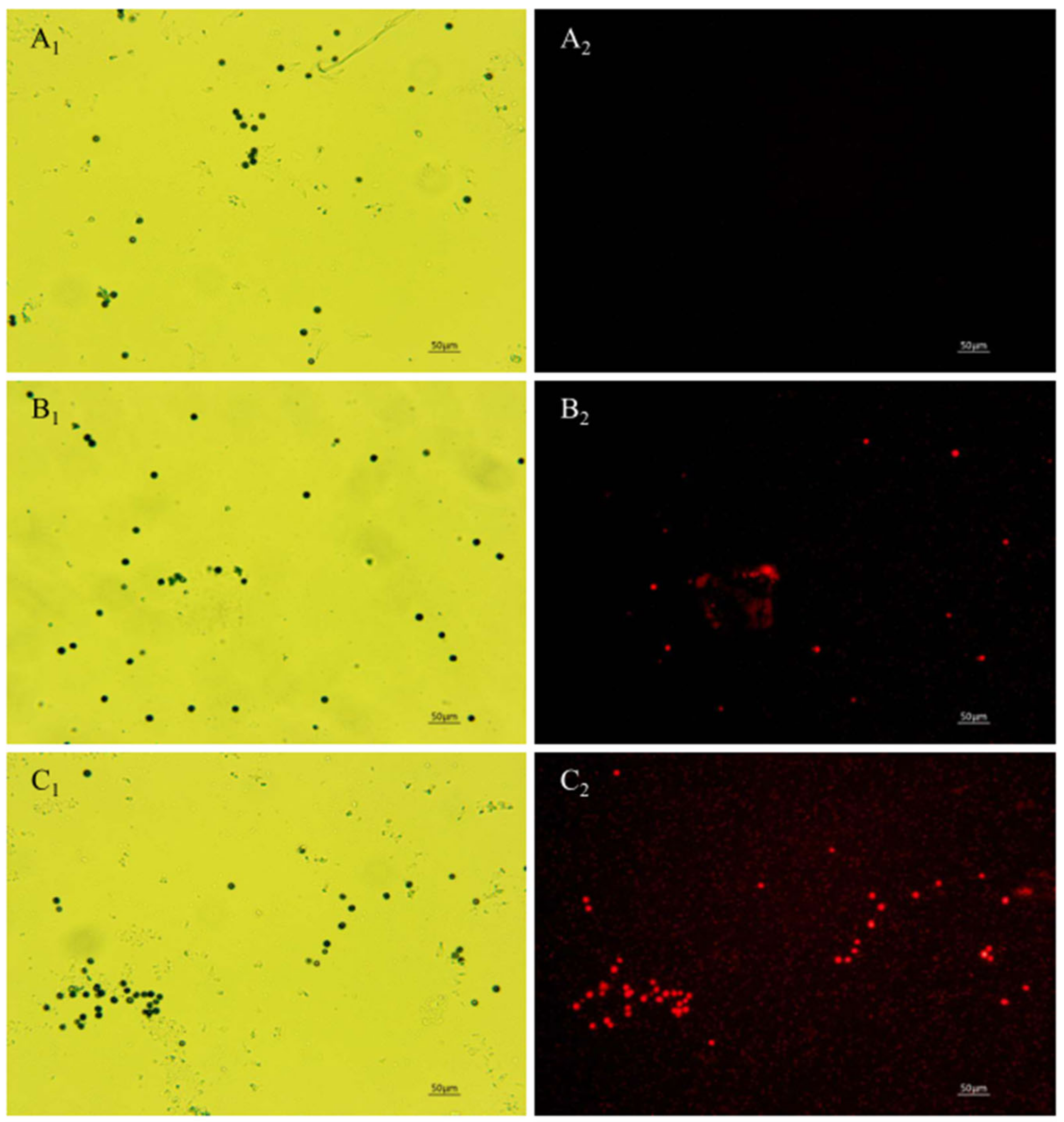
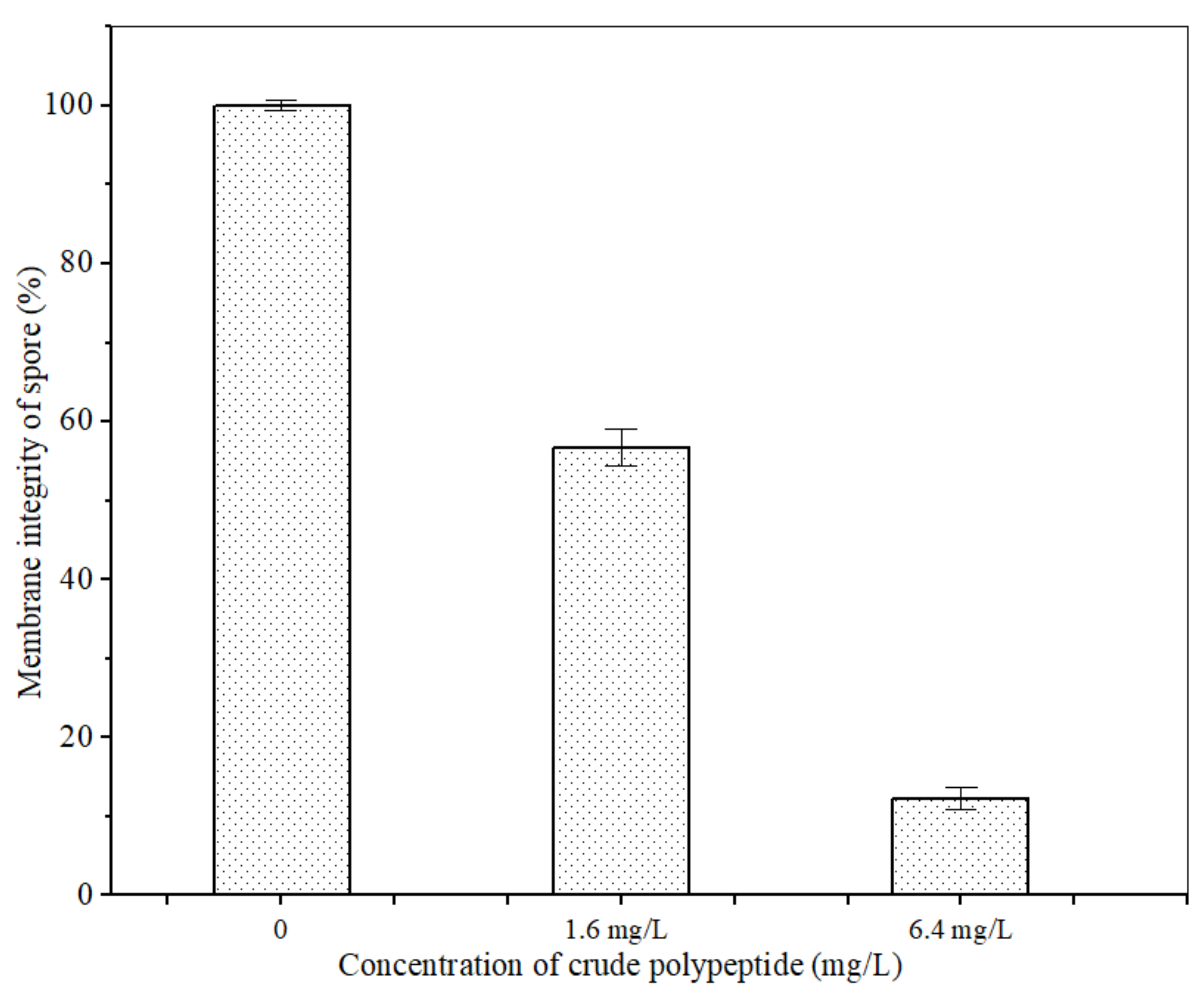
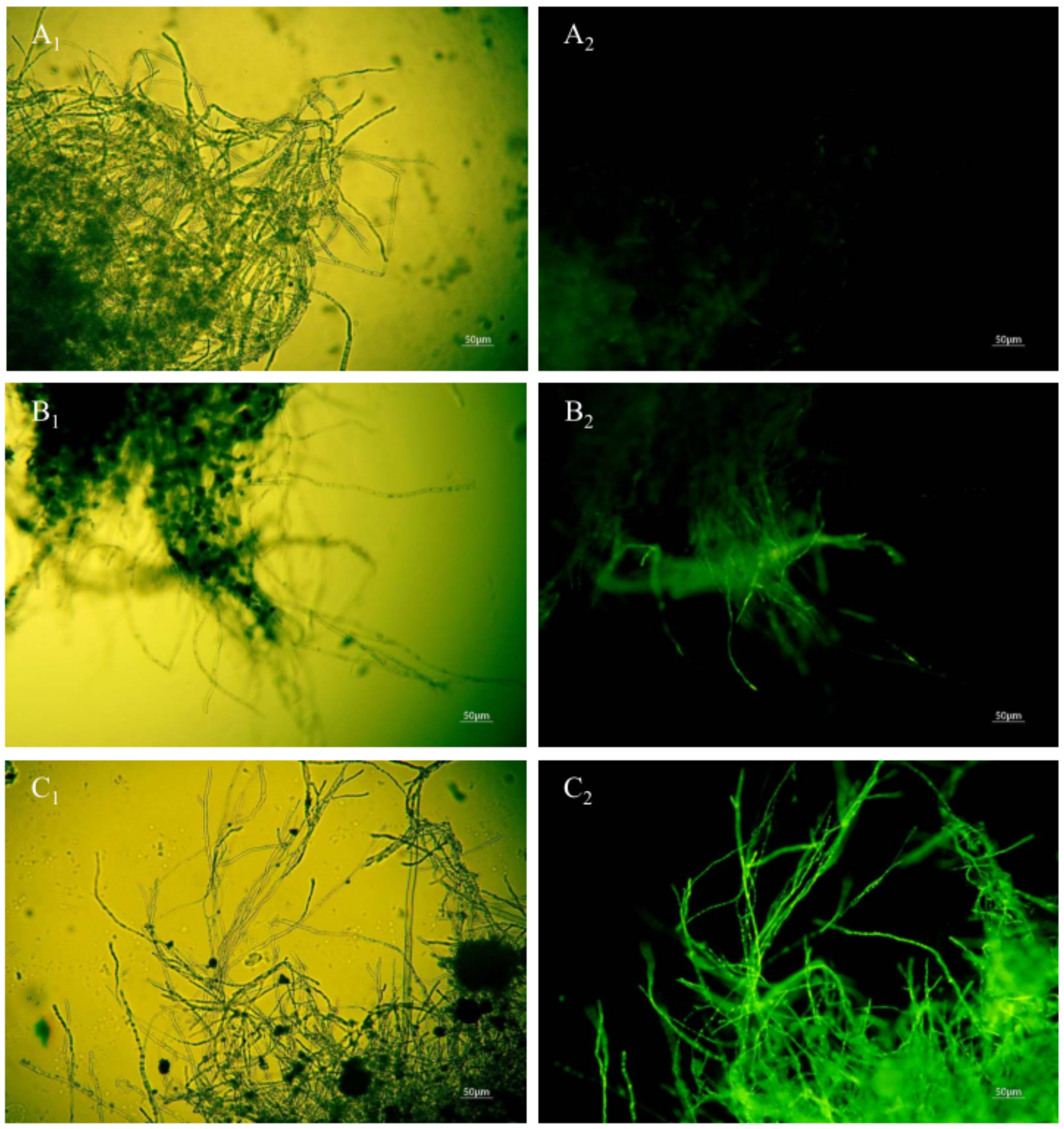
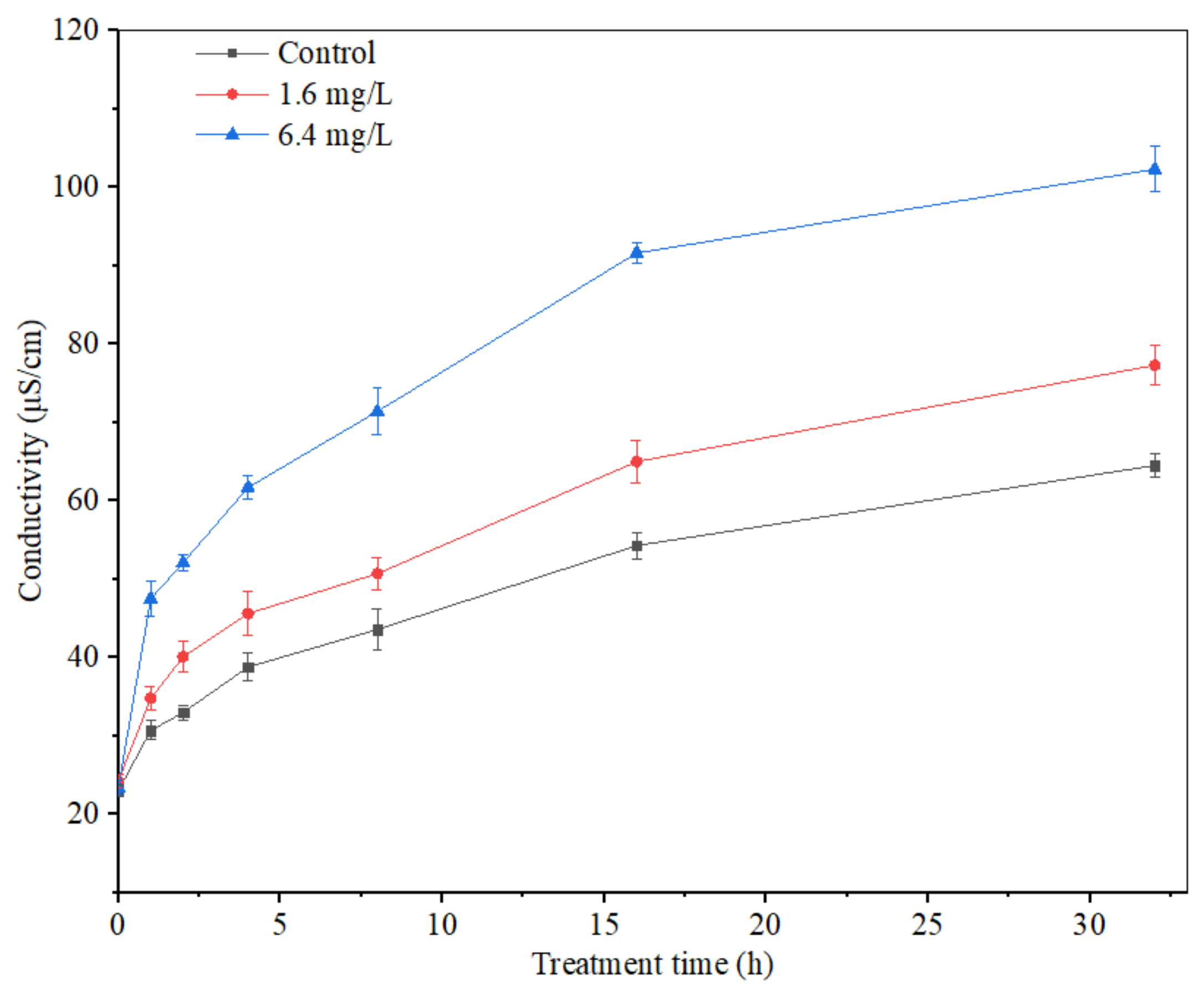
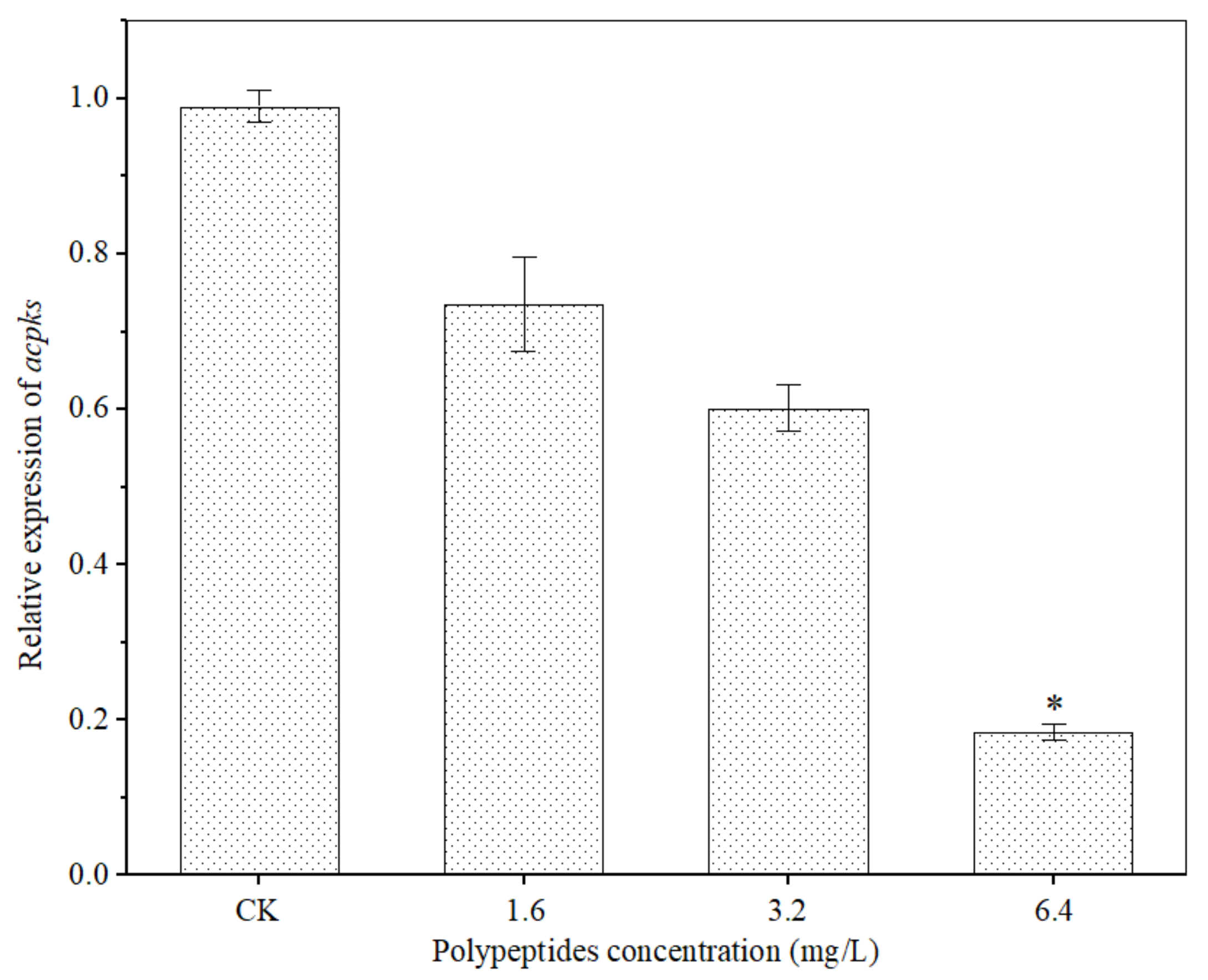
| Primer Name | Primer Sequence (5′–3′) | Reference |
|---|---|---|
| acpks-F | GAGTCTGACCATCGACACGG | [31] |
| acpks-R | GGCGACTGTGACACATCCAT |
Publisher’s Note: MDPI stays neutral with regard to jurisdictional claims in published maps and institutional affiliations. |
© 2022 by the authors. Licensee MDPI, Basel, Switzerland. This article is an open access article distributed under the terms and conditions of the Creative Commons Attribution (CC BY) license (https://creativecommons.org/licenses/by/4.0/).
Share and Cite
Zhao, Z.; Zhang, L.; Lou, Y.; Luo, Y.; Hu, X.; Pan, X.; Wu, H.; Li, J.; Mei, H.; Li, X. Inhibitory Effect of Polypeptides Produced by Brevibacillus brevis on Ochratoxigenic Fungi in the Process of Pile-Fermentation of Post-Fermented Tea. Foods 2022, 11, 3243. https://doi.org/10.3390/foods11203243
Zhao Z, Zhang L, Lou Y, Luo Y, Hu X, Pan X, Wu H, Li J, Mei H, Li X. Inhibitory Effect of Polypeptides Produced by Brevibacillus brevis on Ochratoxigenic Fungi in the Process of Pile-Fermentation of Post-Fermented Tea. Foods. 2022; 11(20):3243. https://doi.org/10.3390/foods11203243
Chicago/Turabian StyleZhao, Zhenjun, Lingling Zhang, Yougen Lou, Yan Luo, Xianchun Hu, Xueli Pan, Huawei Wu, Jianjie Li, Huiling Mei, and Xinghui Li. 2022. "Inhibitory Effect of Polypeptides Produced by Brevibacillus brevis on Ochratoxigenic Fungi in the Process of Pile-Fermentation of Post-Fermented Tea" Foods 11, no. 20: 3243. https://doi.org/10.3390/foods11203243
APA StyleZhao, Z., Zhang, L., Lou, Y., Luo, Y., Hu, X., Pan, X., Wu, H., Li, J., Mei, H., & Li, X. (2022). Inhibitory Effect of Polypeptides Produced by Brevibacillus brevis on Ochratoxigenic Fungi in the Process of Pile-Fermentation of Post-Fermented Tea. Foods, 11(20), 3243. https://doi.org/10.3390/foods11203243





